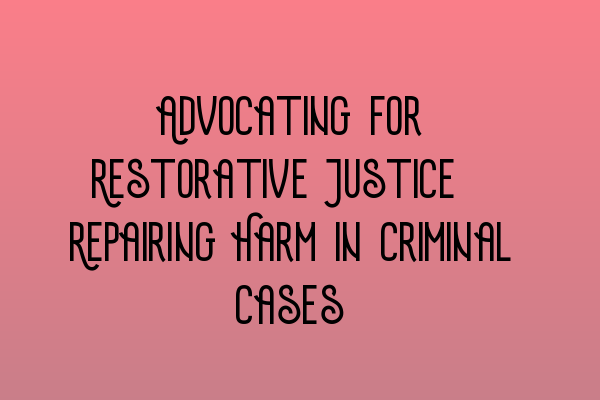Advocating for Restorative Justice: Repairing Harm in Criminal Cases
As criminal defense attorneys, we have a responsibility to not only defend our clients but also to advocate for justice in society. One approach that has gained recognition in recent years is restorative justice. Restorative justice focuses on repairing the harm caused by crimes rather than solely punishing the offender. In this article, we will explore the principles of restorative justice and its benefits in criminal cases.
The Principles of Restorative Justice
Restorative justice is built on three core principles: accountability, community involvement, and repairing harm.
1. Accountability
Restorative justice emphasizes holding offenders accountable for their actions. It encourages them to take responsibility for the harm caused and actively participate in the process of repairing that harm.
2. Community Involvement
Unlike traditional criminal justice systems, restorative justice involves the affected parties and the community in the resolution process. This includes the victim, the offender, their families, and other community members who may have been impacted by the crime.
3. Repairing Harm
The primary focus of restorative justice is to repair the harm caused by the crime. This can include various forms of restitution, such as financial compensation, community service, or direct communication between the victim and the offender to facilitate healing and understanding.
The Benefits of Restorative Justice
Restorative justice offers several benefits over traditional punitive approaches:
1. Victim Empowerment
Restorative justice gives victims a voice and an active role in the resolution process. It allows them to express their feelings, ask questions, and seek answers directly from the offender.
2. Offender Rehabilitation
By involving offenders in the restoration process, restorative justice aims to promote their rehabilitation and reduce the likelihood of reoffending. It provides an opportunity for offenders to understand the repercussions of their actions and to make amends.
3. Community Healing
Restorative justice helps rebuild trust within communities by addressing the underlying causes of crime and creating a space for dialogue and understanding. It allows community members to actively participate in the resolution process and supports the collective healing of those affected.
Implementing Restorative Justice in Criminal Cases
To successfully implement restorative justice in criminal cases, a comprehensive approach is required:
1. Training and Education
Legal professionals, including defense attorneys and judges, should be trained in restorative justice principles and practices. This will enable them to effectively advocate for restorative solutions and navigate the various stages of the process.
2. Collaboration with Community Organizations
Building partnerships with community organizations experienced in restorative justice is crucial. These organizations can provide support services, facilitate dialogue, and offer guidance throughout the restorative justice process.
3. Legislative Reform
Advocacy for legislative reform is essential to ensure that restorative justice principles are incorporated into the criminal justice system. This may include promoting alternative sentencing options, expanding victim services, and formalizing restorative justice practices in legislation.
Advocating for restorative justice is not without its challenges, but the potential benefits make it a worthwhile endeavor. By repairing harm, promoting accountability, and involving the community, we can work towards a more just and compassionate criminal justice system.
For more information on related topics, you may find the following articles helpful:
- SQE 1 Practice Exam Questions
- SQE 1 Practice Mocks FLK1 FLK2
- SQE 2 Preparation Courses
- SQE 1 Preparation Courses
- SRA SQE Exam Dates
